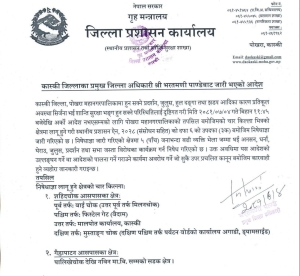At least 19 people have been killed in Nepal in an extremely shocking display of police violence in Kathmandu and other cities. More than three hundred are reportedly hospitalised, while curfew remains clamped in several parts of Kathmandu.
Angad Dhakal, a photojournalist for eKantipur who was documenting the protests just outside the Federal Parliament, said that “police opened fire mercilessly, and without caution as protestors tried to enter the parliament building.” It has been reported that Kathmandu’s CDO had authorised the police to open fire if protesters entered or damaged government premises.
What had begun as a peaceful protest in Kathmandu erupted into a nationwide riot following what could be a state-sanctioned police violence, culminating in the death of nineteen, and counting.
How the events unfolded

Image: Aawaaj News & Research
On September 8, at or around 9 am, hundreds of Gen Z youth gathered at Maitighar Mandala. By the time the procession began marching towards New Baneshwor, the numbers had multiplied.
Calls for the protests had been amplifying since Thursday, September 4, after Nepal’s government announced its decision to ban 26 social media platforms over non-compliance with newly enforced registration rules.
While the fuse may have been the blockage of social media channels, the protests drew on broader frustration with entrenched inequality and elite privilege. In the days leading up to the march, a digital campaign tagged Nepo Kid and Nepo Babies had been circulating widely on TikTok and Reddit. Users compiled and shared videos exposing the lavish lifestyles of the children of Nepal’s political elites and juxtaposed them against visuals of Nepal’s poverty, deprivation, and, in a few instances, underdevelopment.
These videos went viral, disseminating across platforms despite the widespread ban on Facebook and Instagram. They also surfaced a debate: some argued that the children were complicit and knowingly benefited from their parents’ corruption, while others insisted that children should not be blamed for the actions of their parents.
On the ground, the protests gained momentum as thousands of young people chanted for the immediate resignation of former prime minister K. P. Sharma Oli and demanded an end to corruption. Demonstrators held placards and shouted slogans that highlighted how Gen Z was not only aware of elite impunity but also unwilling to tolerate it any longer.
Online, Reddit communities framed the march as a decentralised protest, not tied to any single political party or organisation. The movement also received wide support from the public sphere, including media voices, civic activists, key opinion leaders, and the general public.
However, what was supposed to be a peaceful protest took a drastic turn after the group reached New Baneshwor. A group of people began infiltrating the parliamentary building, and while a large section of the protesters dispersed, many remained. The organisers of the protests also believe that non-aligned groups infiltrated the protests.
A press release by Gen Z Nepal points to the fact that they asked members to safely exit the venue when they saw signs of escalation. According to Dikpal Khatri, “the movement wasn’t about overthrowing the republic, but about uprooting the bugs within it that have been plaguing the country for decades.”
Who remained and who left is not the question we need to ask after such a violent episode and blatant abuse of police authority. The fact remains that police opened fire on the protestors, injuring hundreds, who were then taken to nearby hospitals. It was only later that the death toll began to emerge.
According to Birat, a participant in today’s protests, “the way that today’s protests unfolded tells us a not so surprising question: Does the state really care about its youth? As the death toll keeps increasing, what does the violence say about the government? Gunning down protestors is a stark revelation of how the government handles criticism: authoritarianism.”
The protests, while sparked by calls for accountability by politicians amidst growing corruption, cannot be separated from the wider environment in which they unfolded. The government’s sweeping ban on social media platforms – coming just weeks before the Dashain festivities – has disrupted not only personal but also social and economic aspects of Nepalese society.
Cutting off access has not only impacted economic opportunities but also hampered the ability of citizens to express themselves freely. Critics argue that the ban represents more than a regulatory measure: it is an attempt to stifle dissent and tighten state control over digital speech.
Following the aftermath of the protests, and in the wake of the deaths of public members, the organisers Gen Z Nepal announced their intention to withdraw their movement. Just as the protests spilled from the virtual into the physical, the effects of stifling digital speech has now manifested in real-world consequences. As Nepal navigates the aftermath, the deaths and injuries serve as a reminder of the urgent need for mechanisms to protect citizens’ rights – both offline and online.





